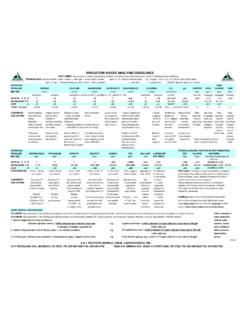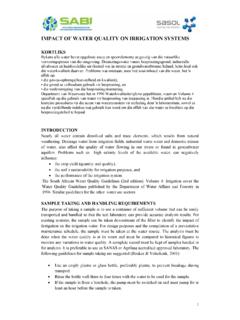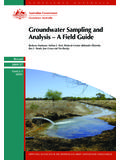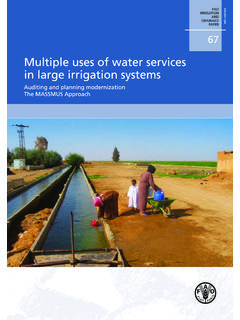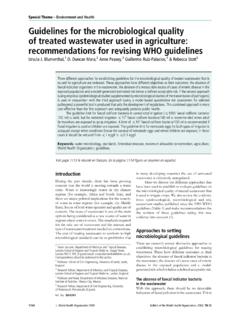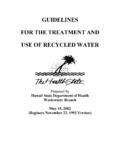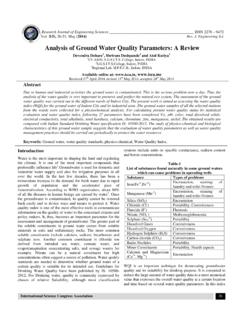Transcription of Guidelines on - Food and Agriculture Organization
1 FAO. Guidelines on irrigation . AND. DRAINAGE. PAPER. spate irrigation 65. by Frank van Steenbergen MetaMeta Research Philip Lawrence HR Wallingford Abraham Mehari Haile UNESCO-IHE. Maher Salman and Jean-Marc Faur s FAO Land and Water Division With contributions from: Ian McAllister Anderson, Karim Nawaz and John Ratsey FOOD AND Agriculture Organization OF THE UNITED NATIONS. Rome, 2010. The Food and Agriculture Organization of the United Nations encourages the dissemination of material contained in this publication, provided that reference is made to the source. The designations employed and the presentation of material in this information product do not imply the expression of any opinion whatsoever on the part of the Food and Agriculture Organization of the United Nations (FAO) concerning the legal or development status of any country, territory, city or area or of its authorities, or concerning the delimitation of its frontiers or boundaries. The mention of speci c companies or products of manufacturers, whether or not these have been patented, does not imply that these have been endorsed or recommended by FAO.
2 In preference to others of a similar nature that are not mentioned. The views expressed in this information product are those of the author(s) and do not necessarily re ect the views of FAO. ISBN 978-92-5-106608-09. All rights reserved. Reproduction and dissemination of material in this information product for educational or other non-commercial purposes are authorized without any prior written permission from the copyright holders provided the source is fully acknowledged. Reproduction of material in this information product for resale or other commercial purposes is prohibited without written permission of the copyright holders. Applications for such permission should be addressed to the Chief, Publishing Policy and Support Branch, Of ce of Knowledge Exchange, Research and Extension, FAO, Viale delle Terme di Caracalla, 00153 Rome, Italy. Or by e-mail to: FAO 2010. iii Table of contents List of figures vii List of tables ix List of boxes xi Acknowledgements xiii Glossary and abbreviations xiv Preface xvi 1.
3 Introduction 1. Definitions and concepts 1. History of spate irrigation 3. Extent and distribution of spate irrigation schemes 5. Classification of spate irrigation schemes 6. Purpose and scope: how to read these Guidelines 9. 2. The social setting 11. Summary 11. Introduction 13. Land tenure 13. Tenancy and sharecropping 16. Livelihood strategies 17. Livestock 18. Wage labour and off-farm incomes 19. Migration 20. Credit facilities 21. Solidarity and mutual assistance mechanisms 22. Basic amenities drinking water and flood protection 22. Gender considerations 24. Threats to livelihoods in spate-irrigated area 25. 3. Hydrology and sediment transport 27. Summary 27. Introduction 29. Data requirements 29. Wadi hydrology and implication for spate design 29. Rainfall-runoff relationship 31. Shape of the spate hydrograph 32. Seepage in wadi bed and groundwater recharge 33. Estimating mean annual runoff and potential irrigated area 35. Using farmers' knowledge 35. Estimating mean annual runoff using a runoff coefficient 36.
4 Calculation of runoff volumes 36. Estimating the proportion of annual runoff that is diverted 36. Design flood discharge 38. iv Incorporating local information in the estimation of flood peak discharge 40. Estimates of flood discharge from water levels 41. Estimating sediment loads 43. Wadi morphology 43. Sediment sizes 44. Sediment transport 46. Measuring sediment size distribution 47. Estimating sedimentation rates on spate irrigated fields 49. 4. Water diversion and control structures 51. Summary 51. Introduction Learning from past experience 57. Diversion structures (intakes) 61. Traditional structures 61. Low-cost improvement to traditional structures 68. New permanent diversion structures 76. Spate canals and water control/dividing structures 88. Traditional canals and water control structures 88. Improved traditional canals and water control structures 88. Wadi bed retrogression and wadi training 95. Bank protection 96. 5. Soil and field water management 101. Summary 101.
5 Introduction 103. Soils management 103. Development of spate soils 103. Land levelling 105. Soil fertility management in spate systems 106. Field water management 108. Field water distribution methods 108. Field water application and the importance of field bunds 113. Moisture conservation 116. Ploughing prior to and after irrigation 116. Conservation tillage and soil mulching 117. Breaking soil crusts 118. 6. Agricultural practices and extension services 119. Summary 119. Introduction 121. Crops grown in spate irrigation 121. Varieties 121. Yields 124. Changes in cropping patterns 127. Options to improve agricultural practices 129. Traditional versus improved varieties 129. Cropping intensities 130. Planting density 130. v Fertilizers 131. Pests and diseases control 133. Crop rotation 133. Ratooning 133. Grain storage 134. The role of livestock 134. Agro-forestry 135. Agricultural extension, training and research 136. 7. Water rights and water distribution rules 139.
6 Summary 139. Managing unpredictability 142. Rules and rights 143. Water distribution rules 144. Rules on land demarcation 144. Rules on the breaking of bunds and timing of water rights 144. Rules on flow division between irrigation channels 145. Rules on sequence of irrigation 148. Rules on depth of irrigation 148. Rules on second turns 149. Rules on large and small floods 151. Rules on maintenance 151. Rules on adaptation to changes in wadi morphology 154. Enforcement 155. Social enforcement through user-based Organization 155. Enforcement through government organizations 156. Codification 158. Changing water distribution rules 159. External factors affecting water rights 159. Changes induced by new infrastructure 159. Implications for spate governance 162. 8. Management arrangements 165. Summary 165. Introduction 166. Farmer management 167. Internal Organization 167. External support the use of bulldozers 170. Combined management of user organizations and local government 171.
7 Agency management 176. Experience from existing large spate systems 176. Conditions for successful agency-based management 178. 9. Economics of spate irrigation 179. Summary 179. Introduction 181. Economic analysis of spate schemes 181. Costs of spate irrigation development 182. vi Balancing investment costs, maintenance costs and the level of service 185. Assessing the benefits of spate irrigation development 188. Integrating risk management in the design of spate systems 188. Taking into account broader livelihood and environmental impacts 189. 10. Spate irrigation in the context of river basin resource management 191. Summary 191. Linking spate irrigation and natural resource management 194. Natural vegetation and biodiversity 194. Catchment degradation 197. River morphology 198. Wind erosion and sand dune formation 200. Flood management 200. Interaction between spate irrigation and groundwater 201. Groundwater recharge 201. Groundwater use in spate schemes 202. Water storage and dams 203.
8 11. Recommendations for interventions in spate irrigation 205. Introduction 205. Learn from past experience 205. Development approach 207. Place spate irrigation within a broader development context 207. Understand the socio-economic context 209. Adapt design to arid zone context 209. Take a basin-wide approach to planning Understand the water balance 210. Design with farmers 210. Adopt an incremental approach to spate improvement 210. Adapt design to operation needs 211. Ensure institutional arrangements for maintenance and operation 212. Invest in soil moisture management and improved agricultural practices 213. Protect fragile ecosystems 214. Recommendations for specific schemes 214. Small schemes using traditional diversion practices 214. New schemes in areas where spate irrigation is being introduced 214. Medium/large schemes using traditional diversion practices 215. Large schemes with improved infrastructure and agency management 215. Schemes with access to sufficient shallow groundwater 215.
9 References 217. vii List of figures Area equipped for spate irrigation in selected countries 4. Spate irrigation as a percentage of total irrigation in selected countries 5. Bullocks in a spate-irrigated area, Ethiopia 19. Spate flood hydrograph from Mishrafeh, Wadi Rima, Yemen, 1981 32. Non-dimensional flow duration curve 37. Stream-gauging site, Wadi Tuban, Yemen 44. Wadi bed widening after emergence onto the coastal plain, 45. Wadi Laba, Eritrea Unstable low-flow channels, Wadi Zabid, Yemen 45. Wadi bed sediment sizes - Structure 1, Wadi Zabid, Yemen 46. Sediment deposits, Wadi Tuban, Yemen 47. Deflecting spur-type traditional intake 62. Traditional spate irrigation intake in Ethiopia 62. Traditional spate irrigation intake in Yemen 63. Traditional spate irrigation intake in Pakistan 63. Diversion bund intake 64. A breach in a deflecting spur in Eritrea 68. Partially breached diversion spur in Wadi Beihan 69. Diversion weir with stepped downstream face 69. Canal head with algamas on both sides of the canal entrance 69.
10 Rehabilitated traditional weir in Wadi Hadramawt 70. Diversion bunds under construction using a bulldozer in Pakistan 72. Side spillway constructed by farmers in Wadi Rima in Yemen 76. Probability that floods with specified return periods will be encountered 78. Layout of a typical curved channel sediment excluder 80. Wadi Rima spate irrigation intake, Yemen 83. Plan of Wadi Rima intake and sediment-settling basin 84. Trash deflector, Wadi Rima intake (2003) 84. Spate diversion structure constructed at Wadi Laba in Eritrea 85. Adurguyay intake, Eritrea 87. Traditional canal diversion bund, Wadi Zabid, Yemen 89. Stepped drop structure, Wadi Zabid, Yemen 89. Gated combined check/drop structure in Yemen 93. Gabion flow bifurcation structure in Eritrea 94. Gated field water distribution structure in a modernized spate 95. system in Yemen Bank cutting and the development of a meander, Wadi Rima, Yemen 96. Bank protection using brushwood and boulders, Wadi Laba, Eritrea 97.










